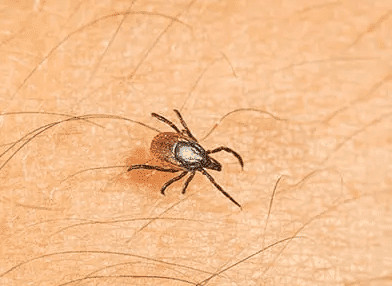Tick-borne illnesses pose a significant public health concern, making it crucial for individuals to remain vigilant, conduct regular tick checks, and take preventive measures to minimize tick bites. By understanding the importance of these practices, we can reduce the risk of contracting tick-borne diseases.
States like Pennsylvania, New York, and New Jersey are notorious for being among the worst states in the United States for tick-borne diseases. The high prevalence of ticks, particularly the blacklegged tick (also known as the deer tick), in these regions contributes to the increased risk. The ticks in these areas are known carriers of pathogens such as Borrelia burgdorferi, the bacterium responsible for Lyme disease, which is one of the most common tick-borne illnesses.
Ticks can transmit various infectious diseases, including Lyme disease, anaplasmosis, babesiosis, Powassan virus, and Rocky Mountain spotted fever, among others. However, it is essential to note that ticks themselves do not cause these diseases. They acquire the pathogens by feeding on infected hosts, such as mice, birds, or deer, and transmit them to humans when they bite. Therefore, by preventing tick bites, we can effectively reduce the transmission of these pathogens.
To mitigate the risk of tick-borne illnesses, individuals should undertake regular tick checks, particularly after spending time in wooded or grassy areas. Removing attached ticks promptly reduces the chances of disease transmission. Additionally, wearing protective clothing, using insect repellents containing DEET, and avoiding tall grass and brushy areas can further prevent tick bites.

Diseases that can be Transmitted by Ticks
Ticks are notorious for transmitting various diseases to humans and animals. These tickborne diseases are caused by pathogens such as bacteria, viruses, and parasites that reside within the tick’s body. The most common tickborne diseases include Lyme disease, Rocky Mountain spotted fever, babesiosis, anaplasmosis, and ehrlichiosis.
Anaplasmosis
Anaplasmosis is a bacterial infection caused by the microorganism Anaplasma phagocytophilum. It is primarily transmitted through the bites of infected blacklegged ticks, specifically the Ixodes scapularis in the northeastern United States and the Ixodes pacificus in the upper midwestern US.
Symptoms of anaplasmosis usually appear within one to two weeks after a tick bite. The most common symptoms include high fevers, severe headaches, muscle aches, chills, and fatigue. Infected individuals may also experience nausea, vomiting, abdominal pain, and cough. One distinguishing characteristic of anaplasmosis is the presence of a diffuse rash in some cases. The rash typically starts on the extremities and spreads to other parts of the body.
There are regional differences in the tick species responsible for transmitting anaplasmosis. In the northeastern United States, the blacklegged tick (Ixodes scapularis) is the primary vector. This species is commonly found in wooded areas and brushy fields, and it typically feeds on deer during its adult stage. In the upper midwestern US, the Western blacklegged tick (Ixodes pacificus) carries the bacterium. This tick species can be found in similar habitats as the blacklegged tick and also feeds on deer during its adult stage.
Babesiosis
Babesiosis is a tick-borne infection caused by the parasite Babesia. The clinical characteristics of this disease can vary, ranging from mild symptoms to severe complications. It is most commonly diagnosed in regions where ticks carrying the Babesia parasite are prevalent, and the diagnosis is typically confirmed through laboratory tests.
The main clinical signs of Babesiosis usually appear around 6-10 days after a tick bite. The most common symptoms include fever, headache, and muscle pain. Other common signs may include fatigue, chills, sweats, and loss of appetite. In severe cases, individuals may experience hemolytic anemia, which can cause pale skin, shortness of breath, and jaundice.
Diagnosing Babesiosis involves a combination of clinical symptoms, laboratory tests, and the patient’s exposure to ticks. Blood tests, such as a blood smear or polymerase chain reaction (PCR), are frequently used to detect the presence of the parasite within red blood cells. Serological tests can also be performed to check for the presence of specific antibodies.
Borrelia Miyamotoi Disease
Borrelia Miyamotoi Disease (BMD) is a tick-borne illness caused by the bacteria Borrelia miyamotoi. It was first identified in Japan in 1995 and has since been found in other regions, including the United States, Europe, and Russia.
Transmission of BMD occurs through the bite of an infected tick, most commonly the black-legged tick (Ixodes scapularis). These ticks can carry multiple pathogens, including the bacteria that cause Lyme disease. BMD is often overlooked or misdiagnosed due to its similarities to Lyme disease and the absence of a specific diagnostic test.
The symptoms of BMD are similar to those of other tick-borne infections and can include fever, chills, headache, muscle and joint aches, and fatigue. However, a distinguishing feature of BMD is the presence of a rash, which affects less than 10% of patients. This rash typically appears as small, red spots or patches on the skin.
Ehrlichiosis
Ehrlichiosis is a tick-borne infectious disease that affects both humans and animals. The symptoms of Ehrlichiosis can vary and are often non-specific, making it challenging to diagnose. Common symptoms include fever, fatigue, muscle aches, headache, and confusion. Some individuals may also experience nausea, vomiting, diarrhea, and respiratory distress. In severe cases, Ehrlichiosis can lead to organ failure and potentially be fatal.
When it comes to diagnosing Ehrlichiosis, healthcare professionals typically rely on various laboratory tests. These tests involve analyzing blood samples to detect the presence of Ehrlichia bacteria or antibodies produced by the immune system in response to the infection. Polymerase Chain Reaction (PCR) tests are often employed to amplify the DNA of the bacteria and improve detection accuracy.
Timely treatment is crucial to manage Ehrlichiosis effectively. Antibiotics, such as doxycycline, are commonly prescribed and generally yield positive outcomes. It is vital to complete the full course of antibiotics as directed by a healthcare provider to ensure eradication of the infection. In severe cases, hospitalization may be required to provide supportive care and close monitoring of vital signs.
Lyme Disease
Lyme disease, caused by the bacterium Borrelia burgdorferi, is a tick-borne illness that can affect various systems and organs in the body. Recognizing the signs and symptoms of Lyme disease is crucial for early diagnosis and prompt treatment.
One of the most common signs of Lyme disease is the occurrence of erythema migrans, a distinctive red rash that often appears in the shape of an oval or bull’s-eye. This rash typically expands gradually over the course of days or weeks and may or may not cause itching or pain.
Joint swelling, particularly in large joints such as the knees, is another common sign of Lyme disease. This swelling and associated pain may come and go, affecting different joints at different times in a migratory pattern.
Facial nerve palsy, or Bell’s palsy, is a sign that occurs in some cases of Lyme disease. It manifests as a sudden weakness or paralysis on one side of the face, usually causing drooping and difficulty in facial movements.
Irregular heartbeat or palpitations, known as Lyme carditis, can also be a sign of Lyme disease. This occurs when the infection affects the heart, leading to inflammation and disturbances in the heart’s electrical signals.
In rare cases, Lyme disease can result in inflammation of the brain or spinal cord, known as neurologic Lyme disease. This can lead to a variety of symptoms such as severe headaches, neck stiffness, cognitive impairment, and sensory disturbances.
Powassan Virus Disease
The Powassan Virus Disease, also known as POW virus, is a rare but serious illness that can cause brain swelling in infected individuals. This disease is rapidly transmitted through tick bites, making it crucial to take precautions to prevent exposure.
Ticks known to spread the Powassan Virus Disease include blacklegged ticks, squirrel ticks, and groundhog ticks. These ticks are commonly found in wooded and grassy areas, making outdoor activities such as camping and hiking potential risk factors for exposure.
When an infected tick bites a human, the virus can be transmitted into the bloodstream. Symptoms of the Powassan Virus Disease may include fever, headache, vomiting, weakness, and confusion. In severe cases, individuals can develop seizures, memory loss, and long-term neurological problems.
Prevention is key in minimizing the risk of contracting the Powassan Virus Disease. It is recommended to wear long-sleeved shirts and pants, use insect repellents containing DEET, and perform thorough tick checks after spending time outdoors. Additionally, reducing tick habitat in outdoor areas can help reduce the risk of tick bites.
Rocky Mountain Spotted Fever
Rocky Mountain Spotted Fever (RMSF) is a tick-borne illness that can be potentially fatal if left untreated. RMSF is caused by the bacteria Rickettsia rickettsii, which is transmitted to humans through the bite of infected ticks. The most common tick species responsible for transmission are the American dog tick (Dermacentor variabilis), the Rocky Mountain wood tick (Dermacentor andersoni), and the brown dog tick (Rhipicephalus sanguineus). These ticks are found predominantly in North, Central, and South America.
The symptoms of RMSF can vary but typically include fever, headache, muscle aches, and a characteristic rash that starts on the wrists and ankles before spreading to the rest of the body. Other symptoms may include nausea, vomiting, abdominal pain, and confusion. RMSF can be difficult to diagnose due to its non-specific symptoms, so a thorough medical history, physical examination, and laboratory tests are necessary for an accurate diagnosis.
The timely treatment of RMSF is essential to prevent serious complications and death. The primary treatment for RMSF is the prompt administration of antibiotics, typically Doxycycline. However, it is important to note that this treatment may need to be adjusted for pregnant women and children under the age of 8. Delayed diagnosis and treatment can lead to severe complications, including organ failure, neurological damage, and even death.
Tick-Borne Relapsing Fever (TBRF)
Tick-Borne Relapsing Fever (TBRF) is an infectious disease caused by spirochetes of the Borrelia genus. It is primarily transmitted to humans through the bites of infected soft ticks of the Ornithodoros species. TBRF is prevalent in various regions of the world, including the Western states of the United States.
Symptoms of TBRF typically include recurring episodes of high fever, headache, muscle and joint aches, and fatigue. These episodes last for around two to nine days, followed by an asymptomatic period. The relapses may occur multiple times, leading to an irregular pattern of illness. In severe cases, TBRF can cause more severe symptoms, such as organ damage and neurological complications.
Diagnosing TBRF involves examining blood smears under a microscope to detect the presence of the Borrelia bacteria. Serological tests, such as enzyme-linked immunosorbent assay (ELISA) and Western blot, may also be performed to confirm the diagnosis.
Treatment for TBRF usually involves administration of antibiotics, such as doxycycline or tetracycline, for a period of 10 to 14 days. In severe cases or when the central nervous system is affected, intravenous antibiotic therapy may be necessary.
Geographically, TBRF is most commonly found in the Western states of the United States, particularly in mountainous and rural areas. It is also prevalent in other regions where the soft tick vectors are present. Adherence to proper tick avoidance measures, such as using insect repellents, wearing protective clothing, and inspecting for ticks after outdoor activities, is crucial in preventing TBRF infection.
Tularemia
Tularemia is an infectious disease caused by the bacterium Francisella tularensis. It is primarily a zoonotic infection, meaning it is most commonly transmitted to humans through contact with infected animals, ticks, or contaminated water or soil.
The incubation period for Tularemia can vary from a few hours to several days, with an average of 3 to 5 days. Common signs and symptoms of the disease include sudden onset of fever, chills, headache, muscle aches, joint pain, and fatigue. Some individuals may also experience swollen and painful lymph glands, especially in the area where the infection entered the body.
Diagnosis of Tularemia can be challenging as the symptoms can mimic other common illnesses. Medical professionals may consider a patient’s history of exposure to infected animals or environments, as well as specific laboratory tests. Blood tests, serologic testing, and cultures are commonly employed to confirm the presence of the bacterium.
Outdoor Tick Control with Horizon Pest Control
Horizon Pest Control offers comprehensive outdoor tick control services to effectively manage tick populations. Our team of experts utilizes various methods, tools, and techniques to keep your outdoor spaces tick-free and ensure the safety of your family and pets.
One of the primary methods we employ is regular inspection and monitoring of the target areas. By thoroughly inspecting these spaces, we can identify tick hotspots, breeding grounds, and areas of high activity. This allows us to implement targeted treatment plans to reduce tick populations effectively.
Our skilled technicians use a combination of environmentally-friendly pest control products and treatments to control and eliminate ticks. These treatments are carefully selected to minimize any potential harm to the surrounding environment while effectively eradicating ticks from your property.
By choosing Horizon Pest Control for tick management, you can experience several benefits and advantages. Our professional team has extensive experience and knowledge in dealing with tick infestations, ensuring effective and long-lasting results.
Utilizing our services not only removes the hassle of dealing with ticks yourself, but it also offers peace of mind knowing that your outdoor spaces are safe and tick-free. Additionally, our environmentally-friendly approach ensures that the treatments used are safe for your family, pets, and the environment.
Don’t let ticks threaten your outdoor enjoyment and well-being. Protect your yard and loved ones with our comprehensive tick control solution. Say goodbye to tick worries and hello to a safer, more enjoyable outdoor experience with Yard Guard Plus. Contact us today to learn more or if you encounter any ticks in or around your home.
Meet Our Horizon Team
Dedicated to Your Satisfaction

Bernie Holst Jr.
Founder

Bernie Holst III
CEO

Kristin Fowler
Executive Vice President

Jose Sanchez
Service Manager

Jason Kushwara
Service Manager

Rich Koptyra
Service Manager

Patrick Livecchi
Service Manager

Nelson Alicea
Service Manager

David Paul
Sales Manager

Ben Gifford
Wildlife Manager

Stacy Jurist
Director of Human Resources

Elsie Riley
Human Resources Administrator

Jessica Mulcahy
Client Experience Supervisor

Ed Campos
Client Experience Manager

Dan Espinal
Quality Assurance Specialist

Karen Carrier
Executive Assistant
Quality Work & Results
Call (201) 447-2530 or Message Us






